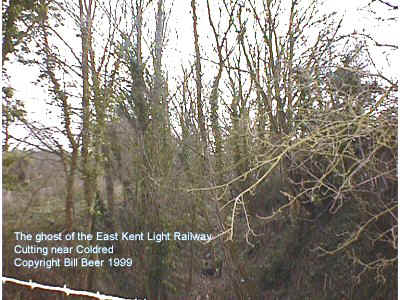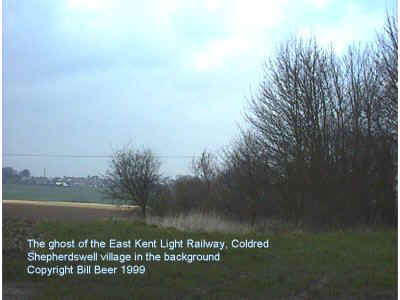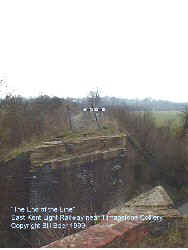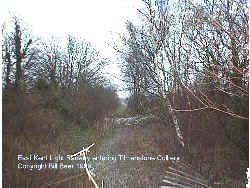The other stretch of line connecting Tilmanstone Colliery
to the Dover - London main line at Shepherdswell (Sibertswold) has
been partially reopened by a group of enthusiasts as a tourist attraction.
The line ends abruptly where the bridge used to span the Shepherdswell to
Tilmanstone road between Eythorne and Tilmanstone Colliery.
The line started from Shepherdswell, from where it
travelled in a north-easterly direction through a tunnel to Eythorne Halt.
Here, two single-track lines branched off: one wound its way south,
skirting round the western side of Coldred to Guilford Colliery; the other
looped into Tilmanstone Colliery before re-joining the line between
Eythorne and Shingleton Farm.
The main line turned north from Eythorne to another halt
adjoining the road from Elvington to Tilmanstone Colliery. From here
it turned slightly to the east, the next stop being at Shingleton Farm, on
the road from Betteshanger village to Chillenden.
Continuing in the same direction, the line followed Gore
Lane to Eastry, where another halt was situated near the Union Workhouse.
A little further on at Gore Halt, the line divided: one branch continued
north-east to a halt at the junction with the Woodnesborough and Staple
roads, the other turned north-west to a halt at what is now called Wood
Ash.
The eastern branch continued in a north-easterly direction
to Buckland Farm, where it turned north before crossing the old Roman road
from Woodnesborough to Sandwich, where there was another halt. From
there it continued north through Great Poulders Farm to the Sandwich-Ash
road, where the main line terminated at a halt midway between Sandwich and
Each End. A single-track line continued north before turning east to
cross the road and the main Sandwich-Ramsgate line just south of
Richborough Castle.
The western branch continued in a north-westerly direction
to Ash Halt, from where it turned south-west to another halt on the
Ash-Staple road. At this point, the line turned west to a halt at
Dambridge Farm, just below Wingham Colliery. Two further halts in
the village of Wingham, on the Adisham road and the Brambling road,
completed the line. The level crossing gate on the south side of the
Brambling road is now the entrance to a garden centre.
For more information on the history of the East Kent
Railway and for details of events, services and membership of the
preservation society, visit the EKR
website, but don't forget to bookmark this
site before you go!



